Articles Menu
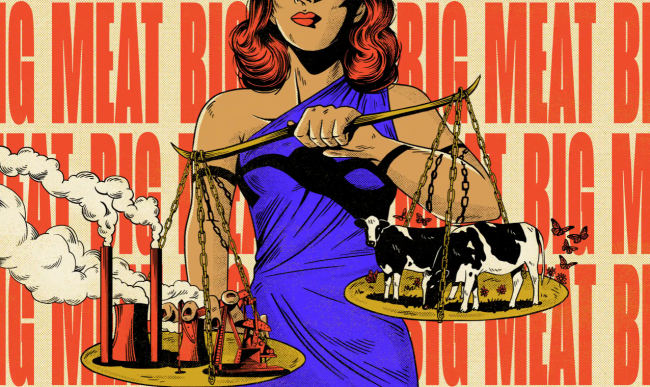
May 3, 2023
The US beef industry is creating an army of influencers and citizen activists to help amplify a message that will be key to its future success: that you shouldn’t be too worried about the growing attention around the environmental impacts of its production.
In particular, it would like you not to be especially concerned about how meat consumption needs to be reduced if we are to avoid the most violently disruptive forms of planetary heating (even if all fossil fuel use ended tomorrow).
It definitely does not want you to read scientific papers showing wealthy nations must reduce meat consumption to keep below the average global temperature rise of 2C, a threshold to stop systems collapse, mass extinctions, fatal heat waves, drought and famine, water shortages and flooded cities.
I know about these industry priorities as I am one of more than 21,000 graduates of a free, by-admission-only, online training course created by the US beef industry called the Masters of Beef Advocacy (MBA) program.
The course is the creation of the National Cattlemen’s Beef Association (NCBA), the beef industry’s main lobby group, and on after completing it I can tell you that you don’t actually get a master’s degree, despite its name.
What you get is multiple misleading – but scientific sounding – narratives about beef industry sustainability and repeated appeals for students to engage proactively with consumers online and offline about environmental topics. Via a private Facebook group for graduates, the NCBA also distributes infographics and industry talking points to deploy in online conversations.
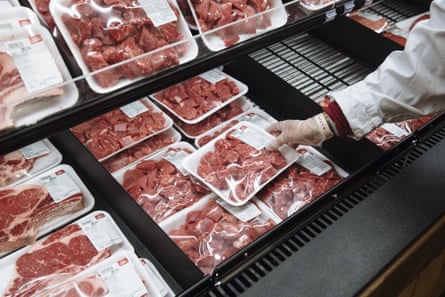
MBA-trained “advocates and spokespeople help educate consumers and influencers about the role of beef in a healthy diet and how beef farmers and ranchers raise beef responsibly and sustainably”, according to one document the Guardian has seen from the Cattleman’s Beef Board, which earmarked $572,700 for the initiative for 2023.
The Cattleman’s Beef Board is the organization that oversees the federally-enshrined beef checkoff program, which funds industry marketing and promotion through a fee ranchers pay on every head of cattle.
“These advocates also help to respond when there is misinformation in the public about beef production and other beef-related issues,” the document says about graduates of the MBA courses.
My interest in doing the course was to better understand cattle industry messaging at a time when beef’s outsized role in climate crisis is under scrutiny. My experience as an MBA student, in addition to other details I uncovered as I reported this story, led me to conclude that the beef industry is engaged in an all-out public relations war to pre-empt environmental criticisms of its products – and that those PR efforts are increasing.
These advocates also help to respond when there is misinformation in the public about beef production
These new details complement the picture provided by the scientists, food systems researchers, behavioral experts and policy specialists interviewed for this story, who say the industry is working to sow confusion about the impacts of animal agriculture – sapping the will for broader political change.
That’s not to say that all beef production is inherently unsustainable. In the right ecological context, and with the right management practices, cattle can help maintain soil health while yielding nutrient-dense edible protein in return, among other benefits. But the truth is that we already eat too much beef for the planet’s good. The world can’t afford the rise in global beef consumption that experts predict – while wealthier nations, whose residents have the most emissions-intensive diets, could make rapid climate gains by choosing to eat less.
This narrative is one that industry-aligned interests badly want to extinguish. Through blog posts, videos, educational assets, op-eds, TV ads, social media campaigns, trained influencers and other channels – many described here for the first time – the industry is trying to convince us all of what the science definitely doesn’t show: that dietary change has no role in climate strategy.
The Cattlemen’s Beef Board and the National Cattlemen’s Beef Association, which says the US produces the world’s most sustainable beef, did not respond to multiple requests for comment.
According to a landmark study in the peer-reviewed journal Science, every kilogram of beef consumed adds a whopping 99.5 kgs of CO2 equivalent greenhouse gasses to the environment, on average. It was the most climate-damaging food studied, and the competition wasn’t even close. According to a subsequent analysis of the results by researchers at Oxford University’s Our World In Data project, beef consumption is 2.5 times – 250% – worse for the climate than the runner-up, sheep and lamb. Eating beef puts more than four times more strain on the atmosphere than eating cheese. It’s more than seven times worse than farmed fish, eight times worse than pork, and 10 times worse than poultry. It’s 21 times worse than eggs.
When compared to fruits, vegetables, grains and legumes, the impacts of beef consumption are even worse. The Science study found that, on average, producing a kilogram of beef contributed over 22 times more to climate crisis than producing a kilogram of rice and 63 times more than a kilogram of wheat. Root veggies, certain tree fruits and nuts were all more than 200 times more climate-efficient by weight than beef.
What makes beef such an outlier? Cows essentially chew for a living – masticating and regurgitating grasses all day long so that tough plant fibers can pass through their multiple stomachs. This process, called enteric fermentation, allows ruminants to nourish themselves – and therefore us – on plants few other animals could eat. But all that chomping comes with plenty of reflux and belching and every burp emits a little methane, a planet-warming gas 28 times more powerful than carbon dioxide over 100 years. (It’s a common misconception that cow farts are what cause warming; from a climate perspective, the burps are what matter.)
In addition, the average steer consumes several metric tons of forage and feed in its life, which means they need a lot of room to roam. But there’s not enough native grasslands on earth to feed all the cows that humans want to eat. So raising cattle often means cutting down forests or displacing other ecosystems to make room for bovines and their food. Taken together, these characteristics – belching, methane and grazing – add up to a climate triple-whammy.
In 2006, the Food and Agriculture Organization of the United Nations (FAO) published Livestock’s Long Shadow, a report that revealed animal agriculture’s significant role in the climate crisis. By showing that livestock production makes up a significant proportion of global emissions – around 18%, though it would later revise that number downward slightly – as well as contributing to other environmental issues including land degradation and water pollution, the report generated headlines and started conversations, helping to make the toll of meat-overconsumption front-page news.
It was also a moment that terrified the meat industry. According to Jennifer Jacquet, associate professor in the department of environmental studies at New York University, Livestock’s Long Shadow helped to inspire meat multinationals and their allies to launch a counteroffensive, working overtime to defend the environmental reputation of meat, especially beef.
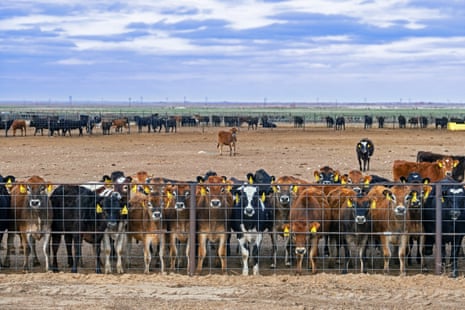
“Since at least 2006 … the industry has been borrowing tactics from the fossil fuel playbook,” Jacquet wrote in a 2021 Washington Post op-ed. “While meat and dairy producers have not claimed that climate change is a liberal hoax, as oil and gas producers did starting in the 1990s, companies have been downplaying the industry’s environmental footprint and undermining climate policy.”
Of the major meat lobbies, the beef industry has arguably done the most to mobilize on the topic of climate. The Guardian’s review of strategy and funding documents from the past decade shows that the cattle business sees itself as perpetually under attack by a variety of hostile forces – with environmental issues of increasing concern.
“The beef industry seemingly is under continuous assault on multiple fronts,” according to a 2022 strategy document from the Cattlemen’ Beef Board. “These attacks frequently are aimed at consumers of beef, bombarding them on a daily basis with negative commentaries concerning … the adverse environmental impact of beef production, its role in the development of antimicrobial resistance, and a myriad of other problems.”
By 2009, the cattle industry had found a new way to drive the narrative, one that cast cattle as a force for environmental good. That year, Frank Mitloehner, a UC Davis animal scientist, co-authored a paper pointing out some issues with Livestock’s Long Shadow, including a faulty calculation that had caused the report’s authors to overstate livestock’s proportionate share of climate pollution. FAO acknowledged the error, and would go on to downgrade its estimate of livestock’s portion of global emissions from 18 to 14.5% – though some experts argue the lower number is now outdated, and may still be too low.
Since at least 2006 … the industry has been borrowing tactics from the fossil fuel playbook
Still, the controversy caught the notice of the mainstream press, with outlets from Fox News to CNN eagerly covering the fallout. Mitloehner seized the moment to talk about FAO’s error. Except in his telling, the mistake was about much more than a few percentage points. In subsequent, widely circulated comments first quoted in a UC Davis press release, he also claimed that reducing greenhouse gas production is possible, “but not by consuming less meat and milk” – something his peer-reviewed critique of Livestock’s Long Shadow didn’t actually prove.
“He proceeded to take this study and critique and go on media and wildly misrepresent his own research,” said Vasile Stănescu, a Mercer University professor who has written a peer-reviewed book chapter on how Mitloehner’s so-called “Cowgate” dustup circulated virally through the media.
Meat industry groups claimed victory.
“Eating less meat won’t curb climate change, air quality expert says,” gushed a blog post published by the North American Meat Institute (NAMI), a meat lobby. “Eating less meat has no impact on climate change,” trade group National Hog Farmer claimed. “Meat and dairy intakes not linked to climate change,” wrote Feed Navigator, a trade publication covering the livestock industry.
The industry had its sound byte – but in all the uproar, three things usually went unmentioned. First, that Mitloehner’s widely shared remarks didn’t actually prove his assertions about the ineffectiveness of dietary change. (His claims “read more like advertising than science”, Stănescu wrote in his book chapter.) Second, that FAO didn’t overestimate livestock’s emissions as much as underestimate the relative impact of transport – the mistake did nothing to inflate livestock’s raw climate contribution, which was and still is huge. And third, that Mitloehner’s study had been funded by a $26,000 grant from the Beef Checkoff Program. Mitloehner didn’t mention the funding in his study, where such a disclosure would be customary. The grant was mentioned in the UC Davis release that generated so much attention, but it mostly went unremarked upon by the press.
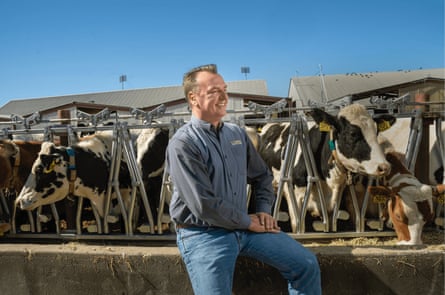
There’s nothing unusual about scientists taking money from industries they study, as long as those ties are properly disclosed. In this case, though, Mitloehner was held up by media and trade groups as a neutral scientist without competing interests, when that wasn’t quite the case.
Responding to questions from the Guardian, Mitloehner said: “Journalists, organizations and even other academics use my comments in ways that I do not always intend. For better or worse, I cannot control what they say or how they say it.”
But if the incident disturbed Mitloehner, you wouldn’t know it. He’d go on to coordinate even more actively with big meat – not just on research, but on messaging.
Mitloehner is a Twitter fixture with a tenacious presence and over 30,000 followers, someone who weighs in with (often contrarian) takes on new developments related to meat production and climate. He’s also known for punchy, headline-grabbing blog posts, as well as defiant op-eds in mainstream outlets – including the San Francisco Chronicle and the Los Angeles Times – that defend the sustainability of beef. A glowing profile in the trade publication Meatingplace called him “the Schwarzenegger of science communicators” and lovingly dubbed him “the Debunki-nator”.
In 2018, UC Davis announced it would open a new research and extension program – the Clarity and Leadership for Environmental Awareness and Research Center, or Clear Center – under Mitloehner’s direction. The center exists to publish and promote research that increases the efficiency of animal agriculture, especially beef. What wasn’t evident at the time, but was revealed last year in reporting by The New York Times, was that the center was established with a $2.9m grant from IFeeder, the non-profit arm of a livestock industry group representing multinational beef packers and other animal agriculture interests. The center has also taken hundreds of thousands of dollars in funding from other industry sources, according to the Times’s report.
As an academic, I noticed that research that was critical to advancing important conversations wasn’t always effectively communicated ...
In his response to the piece, Mitloehner rightly pointed out that it’s normal for researchers to take industry funding. But the Times story also revealed a more unusual dynamic: that the Clear Center has coordinated public messaging campaigns with industry groups.
That seems to have been the goal. In a confidential 2018 memo first obtained by the environmental advocacy non-profit Greenpeace and subsequently published in full on its website, IFeeder president Joel Newman outlined a vision for the center that was largely focused on Mitloehner’s value as a meat industry messenger.
“The communications sub-committee has been working with Dr Mitloehner on expanding his proactive communications, outreach and recognition on key issues,” Newman wrote, adding that “several committee members have forwarded content for Dr Mitloehner to comment/respond to as well as people for him to follow/engage with on Twitter”.
According to the memo, the overt – if not primary – focus of the center would be to support messages that downplay meat production’s environmental toll.
“The Center’s immediate focus is on reviewing current research, filling research gaps and providing impactful messaging to address the significant misinformation regarding the environmental impact of poultry and livestock production,” Newman wrote.
Today, that vision has come to fruition: materials generated by the Clear Center, or featuring Mitloehner, feed the meat lobby’s sprawling counter-messaging machine.
Behind the scenes, Masters of Beef Advocacy graduates coach each other on how best to deploy Mitloehner’s research and blog posts in their activism efforts, according to my review of conversations in their private Facebook group, while industry-aligned websites feature him and his work prominently.
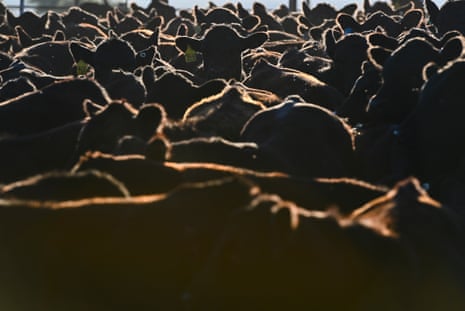
Mitloehner said in his email to the Guardian: “The primary goal of the CLEAR Center is to advance sustainability in animal agriculture. We do that with research and science communications. As an academic, I noticed that research that was critical to advancing important conversations wasn’t always effectively communicated, so the idea was born to create a center that ensures research would be shared.”
He added that his public statements were rooted in research and the purpose of the Clear Center was to “advance sustainability in animal agriculture … with research and science communications”. He said this “cannot be done without engaging the industry” and that by targeting methane it was possible for livestock industry to reach climate neutrality “and eat into historical emissions”.
But other academics interviewed for this article felt that Mitloehner’s messaging efforts and the manner in which they’re routinely amplified by industry, go beyond the bounds of normal scholarly conduct.
“Frank Mitloehner doesn’t echo industry talking points; he seems to create entire messaging strategies. Those messages are then echoed by trade groups multiple years afterward. He is then commended by industry, including his funders, for broadcasting those messages across social media and to political groups,” said Matthew Hayek, an assistant professor at New York University who studies agriculture’s greenhouse gas emissions impacts.
“Only a fraction of the Clear Center’s work seems focused on methane reduction,” Hayek said. “More broadly, the Clear Center creates industry-friendly messages to help fight off a wide range of proposals to tackle climate change. Those proposals include meat reduction, investments in alternative proteins and producer buyouts away from animal agriculture. His/their positions diverge from climate expert consensus and cherry pick scientific findings to undermine how drastic those proposals’ mitigation potential actually is or could be.”
Frank Mitloehner doesn’t echo industry talking points; he seems to create entire messaging strategies.
A five-year strategy document written in 2020 by a handful of leading cattle industry organizations identified a need to turn up the heat in its messaging fight. Their highest priority was to “demonstrate beef’s positive sustainability message and key role in regenerative agriculture”.
“It is highly likely the beef industry will continue to be threatened by legislation and/or regulations aimed at curbing greenhouse gas emissions,” the document said. It went on: “The task force believes it is more important than ever to aggressively promote the multiple advantages of beef and educate consumers on how beef fits into a healthy lifestyle and sustainable diet.”
The meat industry has long used lobbying and marketing to improve the business climate for its products. In a paper she co-authored in 2021, Jacquet described the scope of these efforts, including intensive lobbying of government officials, millions of dollars of campaign contributions and public (often misleading) net-zero commitments. Then there’s the marketing.
The Cattlemen’s Beef Board – which contracts with the National Cattlemen’s Beef Association (NCBA) for its marketing and promotion efforts – has long had significant cultural impact. Its famous early 1990s “Beef: it’s what’s for dinner” spots, backed by music from Aaron Copland’s Rodeo suite, are among the most iconic TV commercials of all time.
Since at least 2018, NCBA has also hired top-shelf creative agencies and public relations firms – including Ketchum, VML&R and Linhart PR, all of whom also have fossil fuel industry clients – to help devise its messaging and strategy. And while its marketing efforts have historically shored up support for beef as the centerpiece of the American plate, those efforts have recently taken on a much more environmental focus. The NCBA-operated website BeefItsWhatsForDinner.com contains numerous articles and fact sheets downplaying beef’s role in the climate crisis.
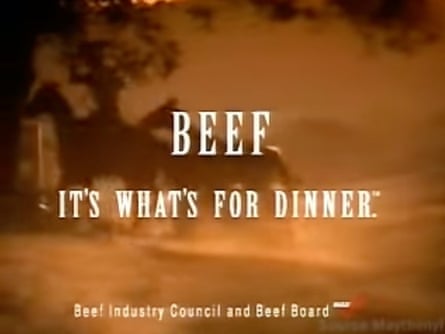
In a private video training session for beef industry influencers, Sarah Reece, NCBA’s senior executive director of brand marketing, described a plan that involved paid advertising on Google, Facebook, Reddit, Youtube and Instagram, as well as video and audio ads spots on ESPN, Spotify and Sirius XM Radio. One sustainability-oriented marketing effort, which ran from April to June 2021, generated 60m impressions and drove nearly 90,000 clicks to Beef: It’s What’s For Dinner web pages and content, including material muddying the waters about beef’s links to climate. It’s “a surround sound approach to reach consumers”, Reese said. “We’re getting them everywhere they are.”
Those efforts appear to be going strong in 2023. According to strategy documents posted to the Beef Board’s website, NCBA requested $9.1m for content marketing and paid advertising this year – all of which will serve to improve beef’s image, and some of which will specifically “communicate the net climate and environmental impact of beef production”.
Then there is the Masters of Beef Advocacy (MBA) course, though the NCBA has even more ambitious plans to combat what it calls “misinformation”.
Using checkoff money, NCBA has developed what it has called a “Digital Command Center” – a sophisticated online monitoring system that tracks media outlets and social media for more than 200 beef-related topics. Hosted in Denver in a space that “looks like a military operations center combined with the TV section at an electronics retailer”, according to a recent Cattlemen’s Beef Board mailer sent to ranchers, the Command center alerts members of NCBA’s issues management and media relations team whenever stories or online chatter rise above a certain threshold. It’s staffed 24 hours a day, 7 days a week, with personnel redundancies built in to make sure someone’s always watching.
One goal is to enable the industry to respond to emerging public health or economic emergencies. But the center, which received $742,400 in checkoff money for fiscal year 2023, is also used to keep track of public conversations around beef’s sustainability in real-time – and to deploy “talking points, media statements, fact sheets, infographics, videos and various digital assets” as necessary to shift the terms of conversation.
NCBA calls it “proactive reputation management”: a strategy that entails monitoring the internet for messaging opportunities, then leaping in to burnish beef’s image whenever it’s advantageous. In 2021, for instance, during Climate Week NYC – a time when online discussion of beef’s sustainability tends to skyrocket, according to NCBA’s monitoring tools – the organization worked to place pro-beef op-eds in news outlets, ensuring the online chatter would include its perspective. In the private video for MBA students, Marissa Pooley, NCBA’s senior director of issues and reputation management, explained how the NCBA collaborated closely with chef and rancher contributors to place independent-seeming pieces in outlets like The Denver Post and Denver alt-weekly Westword.
Climate Week NYC was “something we really took a big swing at and leveraged as a reputational opportunity”, Pooley told students. She said content related to the op-eds generated millions of views.
Journalists, organizations and even other academics use my comments in ways that I do not always intend.
It was the same playbook NCBA had used in May 2021. That spring, two high-profile culinary institutions dropped meat to protest livestock’s outsized role in the climate crisis: food media outlet Epicurious decided to stop featuring new recipes with beef, and Manhattan restaurant Eleven Madison Park took meat off its menu entirely. The news made headlines. And when NCBA noted the trend in its monitoring tool, it sprang into action.
NCBA started by defending beef’s sustainability in a slate of paid ad buys – which ran in outlets like the New York Times and the Washington Post – but it didn’t stop there. In the private video for Masters of Beef Advocacy students, Pooley described how NCBA worked with celebrity chef Lamar Moore to write a piece insisting on a central place for beef on the plate. That story – which ran with the subhead “Why cutting meat from the menu (or magazine) is misguided,” ran in LA Weekly – and was plugged repeatedly on Twitter by NCBA (and other industry accounts) as if it had no connection to the story.
In fact, none of the pieces NCBA privately admits it played a role in – in LA Weekly, Westword and The Denver Post – disclosed the trade group’s participation.
The industry sees these messaging efforts as part of an existential battle for survival. In the training video, NCBA leaders cited data that found 47% of Americans aren’t sure about the sustainability of beef. That persuadable middle is a top priority for the industry, they said, as whoever reaches them best has the power to sway the balance of public opinion.
The industry must engage in a “defensive strategy”, Pooley told MBA students. Sustainability, she said, “has the potential to become a crisis if we don’t address it early”.
[Top: The industry is trying to convince everyone … that dietary change has no role in climate strategy. Illustration: Lola Beltran/The Guardian]